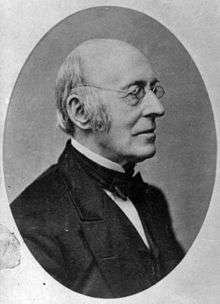New England Non-Resistance Society
The New England Non-Resistance Society was an American peace group founded at a special peace convention organized by William Lloyd Garrison, in Boston in September 1838.[1] Leading up to the convention, conservative members of the American Anti-Slavery Society and the American Peace Society expressed discomfort with Garrison's philosophy of "non-resistance" and inclusion of women in public political activities. After conservative attendees opposing Garrison walked out of the convention in protest, those remaining formed the New England Non-Resistance Society.

The Society condemned the use of force in resisting evil, in war, for the death penalty, or in self-defense, renounced allegiance to human government, and because of the anti-slavery cause, favored non-union with the American South.
The New England Non-Resistance Society was one of the more radical of the many organizations founded by William Lloyd Garrison, adopting a Declaration of Sentiments of which he was the principal author, pledging themselves to deny the validity of social distinctions based on race, nationality or gender",[2] refusing obedience to human governments, and opposing even individual acts of self-defense.[3] In the Society's “Declaration of Sentiments” Garrison wrote, "any person without distinction of sex or color, who consents to the principles of this Constitution may become a member and be entitled to speak at its meetings."[1] The Society rejected loyalty to any human government; one historian has described the Non-Resistance Society's "basic outlook as that of philosophical anarchism".[4][5]
The declaration was signed by 44 people, of whom 20 were women. Maria Chapman became the editor of its publication, The Non-Resistant (1839 - 1840),[3] along with Edmund Quincy (1808-1877), and William Lloyd Garrison and started publication in 1839. The first annual meeting was held in Philadelphia, Sept 24-27, 1839. The publication lasted only two years but was indicative of the millennial character of parts of the reform movement.[6]
Among the members were Adin Ballou, Amos Bronson Alcott, Maria Weston Chapman, Stephen Symonds Foster, Abby Kelley, Samuel May, Parker Pillsbury, and Henry C. Wright. [7]
The Non-Resistance Society held its last meeting in 1849.[4]
The organization has been considered by one historian to be a "relatively exclusive vehicle of the radical [Boston] upper class"[8]
References
- 1 2 Peter Brock Pacifism in the United States, from the Colonial era to the First World War. Princeton, N.J., Princeton University Press, 1968, pp. 539-42.
- ↑ Walters, Ronald G. American Reformers: 1815 - 1860. New York: Hill and Wang, 1997 ISBN 978-0-8090-0130-9 p. 120 Google Books
- 1 2 Yellin, Jean Fagan, and John C. Van Horne. The Abolitionist Sisterhood: Women's Political Culture in Antebellum America. Ithaca: Cornell University Press, 1994. ISBN 978-0-8014-2728-2
- 1 2 Reichert, William O.,"The Philosophical Anarchism of Adin Ballou", Huntington Library Quarterly, Vol. 27, No. 4 (August 1964), (pp. 357–374).
- ↑ "...Ballou was a lecturer for temperance and the American Anti-Slavery Society, as well as president of the pacifist and Christian anarchist New England Non-Resistance Society." Calhoun, Craig. The Roots of Radicalism: Tradition, the Public Sphere, and Early Nineteenth-Century Social Movements. University of Chicago Press, 2012 ISBN 0226090841 (p. 372).
- ↑ Malone, Dumas, ed. 1935. Dictionary of American Biography, Vol. VIII, pp. 306-07. New York: Scribner's.
- ↑ Curti, Merle E., "Non-Resistance in New England", The New England Quarterly, Vol. 2, No. 1 (January 1929), pp. 34–57.
- ↑ Hansen, Debra Gold. Strained Sisterhood: Gender and Class in the Boston Female Anti-Slavery Society. Amherst: University of Massachusetts Press, 1993. ISBN 978-0-87023-848-2 p. 105 Google Books